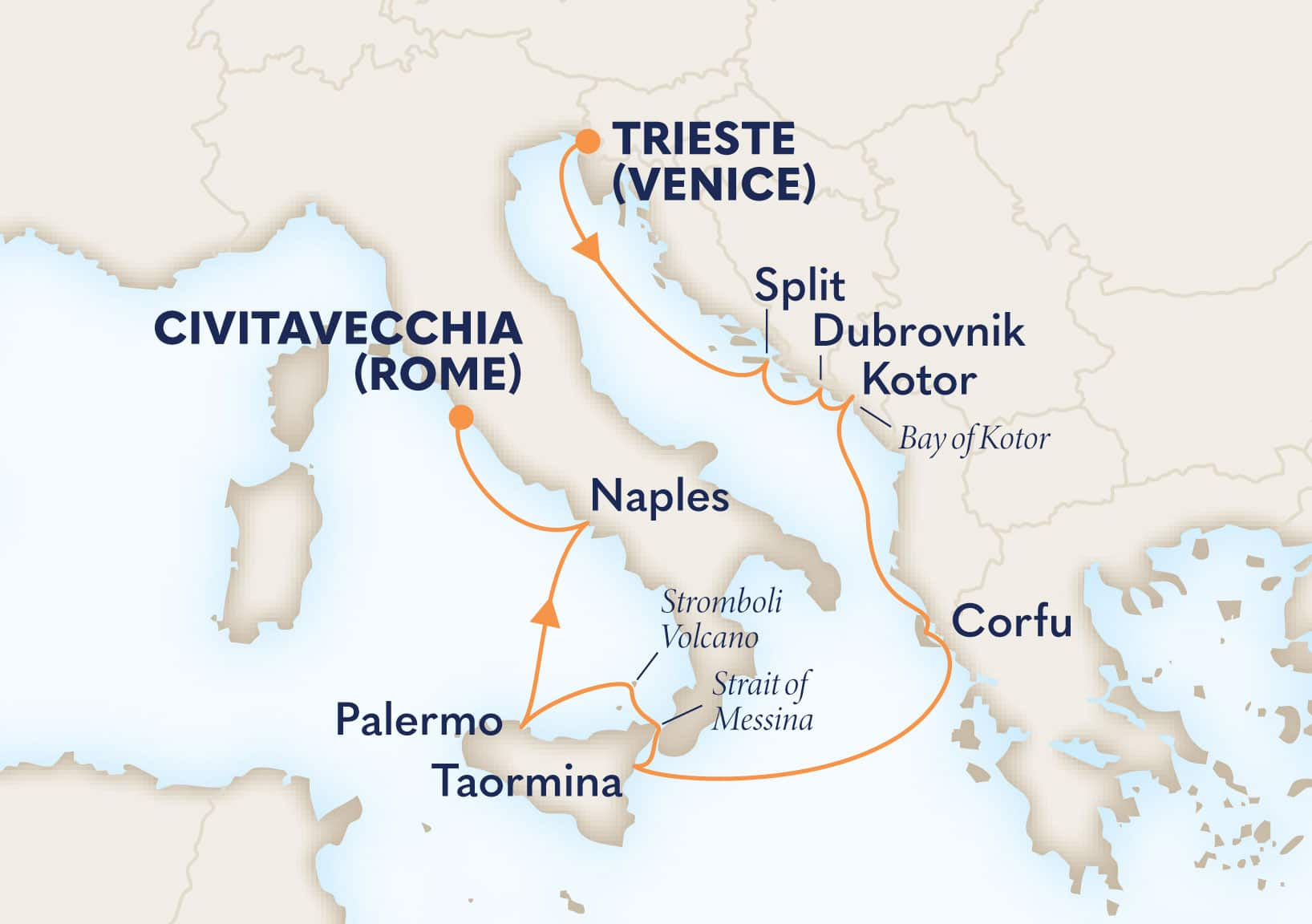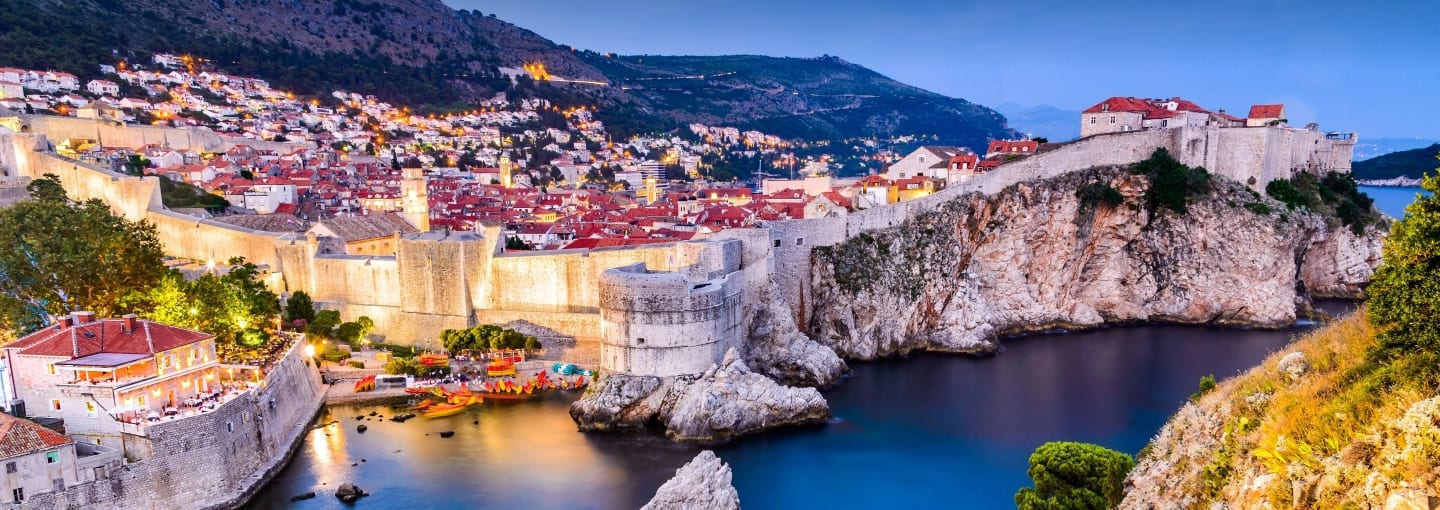Around Italy's Boot











| from | NZ$2,999 |
per person |
Duration: 10 Nights
Destination: Europe, Mediterranean
Cruise Line: Holland America Line
Ship: Oosterdam
Cabin: Inside Twin Share
Departure/Arrival Port: Trieste to Civitavecchia/Rome
Deal Code: DC8S3RQ
Description
Pricing based on departure date: 14 May 2026
Split’s red-orange rooftops, Dubrovnik’s ancient walls, Sicily’s renowned cuisine, the smoldering Stromboli Volcano and more stir your senses on this extraordinary cruise.

Itinerary Highlights:
On the southern end of Croatia's Adriatic coast, Dubrovnik staked its claim to glory during the 450 years it existed as the independent Ragusan Republic, shoulder to shoulder with mighty forces like Venice and the Ottoman Empire. Once a renowned seafaring, shipbuilding and trading center, today it's an enchanting tourist destination. Dubrovnik seduces sightseeing visitors with its polished (and very clean!) limestone streets, theatrical architecture, charming café, welcoming restaurants and distinctive shops along scenic side streets. The natural backdrop, much of which is protected, consists of pine and cypress forests and the shimmering Adriatic, dotted with uninhabited islands. Visitors quickly discover that the wider Dubrovnik area is just as striking as its main attraction—the Old Town.

Cruising into the Bay of Kotor, you'll be wowed by the dramatic beauty of this coastal Montenegrin town. Dreamy seafront villages are set to a backdrop of mountains plummeting into the Adriatic Sea, while the stone labyrinth of the Old Town is filled with medieval architecture and historic monuments—as well as the narrowest street in the world. The area only became part of Montenegro after WWII, and as such has a very different history to the rest of the country. Kotor escaped Ottoman rule and developed as an important Venetian trading post, before being conquered by the Austro-Hungarian Empire, France and Russia. The city pays tribute to this dynamic history with Venetian gates, Napoleon's theater and Austrian prisons all waiting to be discovered. There's a reason it was named a UNESCO World Heritage Site. The cruise ship dock is across the street from the Sea Gate, the main entrance to the Old Town, while a conveniently located taxi stand by the harbor gates allows for easy exploration of the region.
Corfu is the pearl of the Ionian Sea, attracting royalty from across Europe in the 19th century, and modern celebrities from all over the world ever since. The island reflects a triple heritage. As well as being undeniably Greek, the culture and food also show a clear nod towards nearby Italy, particularly Venice, whose fortresses dot the island. The British influence may be unexpected, but as they ruled the island for many years, they have left such surprises in the Mediterranean as cricket and ginger beer.The bustling atmosphere of Corfu Town remains elegant, infused with culture and history. Parts of the rest of the island have been overdeveloped, but there are still great swaths that epitomize why the Greek islands are still regarded as the most beautiful in the world, with white-sand beaches backed by verdant mountains hiding traditional old villages. It is easy to see how Corfu has inspired generations of writers: from Shakespeare, through Edward Lear, to Gerald Durrell. A true gem.

Located on Sicily's east coast, just north of the active volcano Mt. Etna, Taormina has long drawn visitors with its stunning coastal scenery, thanks to its vantage point 204 meters (669 feet) above the Ionian Sea. Literary giants like Goethe and D.H. Lawrence spent time here, and more recently the town has become a popular spot for fans of the Godfather films, with some scenes shot in the area. Founded in the 4th century B.C.E., the town has a compact historic center that’s best explored on foot. Start with a visit to the ancient Greek Theater before shopping and people-watching along the Corso Umberto. A cable car makes it easy to reach the beach at Lido Mazzaró—one of the most picturesque and popular on the island, where you can frolic in the crystal clear water or sip a cold drink at one of the beach bars.
Evening cruising Stromboli Volcano: One of eight Lipari Islands off the north coast of Sicily, tiny Stromboli is the most active—in that it is home to the second-most-active volcano on Earth, one that's been erupting continuously for more than 2,000 years. Most visitors who cruise around the island have a singular focus: the volcano. It perfectly matches one’s image of the legendary geographical feature—cone-shaped, topped by a fiery crater that spews fountains of glowing red lava, and best seen at night. One side of Stromboli remains forever burned and blackened by perpetual eruptions. Occasionally—every two to 10 years—major flow events occur, sending a river of molten rock down the mountainside to the sea through a gorge called the Sciara del Fuoco (or Stream of Fire). Smaller eruptions happen more frequently, however, usually every 30 minutes to an hour, with blasts of lava shooting from the mouth of the caldera. Despite being an active-volcanic island, Stromboli has two settlements: Stromboli Town in the island’s northeastern corner and smaller Ginostra on its west coast. The former features black-sand beaches, several hotels and most of the tourist services.

Palermo, Sicily's capital, is a marvelously jumbled, crumbling blend of old and new—a canvas upon which the region's complex and ever-shifting history has been painted. Over the centuries, the port of Palermo was controlled by forces from the far corners—from Phoenicians, Greeks and Romans, to Arabs from North Africa, and then Normans from France, who oversaw a renaissance during which many of Palermo's iconic landmarks and modern tourist attractions were built. To see some of the vestiges of ancient empires, take a day trip from Palermo to the Valley of the Temples at Agrigento, a UNESCO World Heritage Site. Its Greek and Roman ruins, including the Temple of Concordia, remain wonderfully intact. Within the city itself, explore the attractions in historic neighborhoods such as the Arab district of La Kalsa, home to the finery-filled Palazzo Mirto. The Quattro Canti (Four Corners) lies in the heart of the old city, with Piazza Pretoria on the corner. From there it's only a short distance to Palermo's Norman Palace, another UNESCO World Heritage Site and one of Palermo's star attractions, which houses the Palatine Chapel, famous for its intricate mosaics.
Your Ship: Oosterdam
Oosterdam, a Vista-class ship, recently emerged from dry dock with exciting updates—including completely refreshed suites and new lounge, dining and entertainment venues, such as Music Walk™, with Lincoln Center Stage, B.B. King’s Blues Club and Billboard Onboard. Guests can choose from among delectable specialty restaurants, hone culinary skills with EXC Port to Table and thrill to BBC Earth Experiences.
Itinerary Overview
Trieste, Split, Dubrovnik,Kotor, Corfu, Taormina, Cruising the Strait of Messina, Palermo, Naples, Civitavecchia/Rome
Online Enquiry
Terms & Conditions
All fares are displayed in NZD, and pricing is per person based on twin share occupancy unless stated otherwise. Although all due care is taken to keep information as up-to-date as possible, pricing and availability are subject to change without notice: due to varying timing schedules of supplier automated update processes; currency fluctuations; fuel surcharges or government tax & fee changes and may not be guaranteed until paid in full. Gratuities may be an additional onboard charge depending on particular cruise line selected. Please ask your cruise consultant for any clarification of Terms & Conditions.











